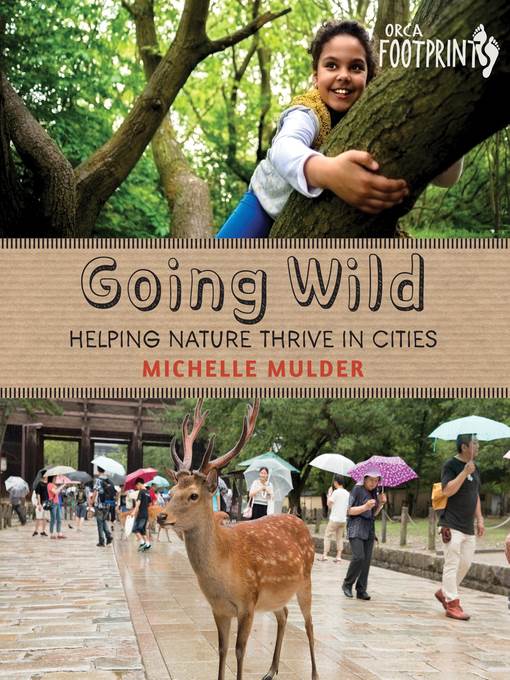
Going Wild
Helping Nature Thrive in Cities
فرمت کتاب
ebook
تاریخ انتشار
2018
Lexile Score
1020
Reading Level
6-8
نویسنده
Michelle Mulderناشر
Orca Book Publishersشابک
9781459812895
کتاب های مرتبط
- اطلاعات
- نقد و بررسی
- دیدگاه کاربران
نقد و بررسی

February 1, 2018
Dependent on what they could find in nature for thousands of years, humans eventually developed agriculture and banded together into cities, but now they're looking for ways to bring the natural world into urban environments.The author of Pocket Change (2016), Trash Talk (2015), Every Last Drop (2014), and similarly eco-conscious titles continues this series with a look at urban rewilding. In four chapters, she describes the development of cities, the environments they overlaid, current examples of efforts to bring nature back, and how kids can get involved. She mentions the effects of the Industrial Revolution, efforts to disconnect indigenous peoples from their links with nature, the origin of lawns, and instances of large, wild animal visitors. Readers may have difficulty discerning the organization that underlies her argument, but they will certainly get her message: we all need a stronger connection to the natural world. She encourages young people to get outside and get their hands dirty (it's healthful!) and to get involved in citizen-science efforts. Her text is made more accessible with clear subheadings, italicized words (defined in a glossary), and plentiful photographs from around the world which include a variety of ages and races. Sidebars offer interesting "Wild Facts" and "Making Tracks," examples from her own life.Recommended for settings where others in the series have been useful. (resources, index) (Nonfiction. 8-12)
COPYRIGHT(2018) Kirkus Reviews, ALL RIGHTS RESERVED.

March 1, 2018
Gr 4-7-Mulder adds to her catalog of environmentally focused titles with this account of all of the ways nature has to adapt to urban environments. There are a lot of riveting ideas briefly discussed here, including the connection between rats and the bubonic plague, the history of forcing Indigenous children into residential schools, and the connection between microbes and mental health. The book's biggest challenge is its effort to explain so many complex historical topics prior to exploring the current, delicate urban ecosystem. However, the book more successfully explains the enormous impact human habitation has on the surrounding natural world. Sidebars include "Wild Facts" and "Making Tracks" that provide some extra fun information as well as personal anecdotes from the author. A glossary of unfamiliar vocabulary words (such as habitecture) is also helpful. There are also suggestions on how readers can improve their relationship with nature by composting, planting seeds, and spending more time enjoying the outdoors. VERDICT Perfect for inspiring readers to explore the natural world while also encouraging discussion about the environmental changes caused by humans.-Alyssa Annico, Youngstown State University, OH
Copyright 2018 School Library Journal, LLC Used with permission.

March 19, 2018
In an addition to her Orca Footprints series of ecologically minded titles, Mulder promotes the idea of planning urban spaces that coexist in greater harmony with nature. Writing in short, casual sections, Mulder offers a brief, general history of how humans have become increasingly cut off from the wilderness and centralized within urban areas. Why does this matter? “Because no matter how much our cities usually separate us from the rest of nature, we humans are still part of the natural world,” she explains. With photographs of deer, foxes, coyotes, and other animals spotted within city limits, she lays out the challenges and opportunities for creating more green space. She references innovative urban planning—for example, in Helsinki, Finland, planners have created “green fingers,” or stretches of land within cities that enable wildlife to freely roam without encountering humans or vehicles. For readers who wish to help “invite nature back in,” Mulder suggests growing native plants in urban spaces, building bat houses, creating litter-free spaces, and composting. A slim yet thoughtful volume that offers an intriguing and achievable vision. Ages 9–12.

February 15, 2018
Grades 4-7 The latest volume from the Footprints series beats the drum for the rewilding of urban areas with native trees and other plants, the depaving of some streets to create more natural areas of wildlife habitat, and the recognition that city people are healthier and happier when they have more contact with nature. Several chapters trace the development of cities from ancient times to the present, with discussions of topics such as the surprising origin of lawns and the changes brought about by bicycles and cars. The book also describes ways in which cities are encouraging plants and animals to thrive and discusses how kids can help. While Mulder approaches her topic with enthusiasm, she notes that balancing an urban ecosystem is a complex process and that not every animal makes a good neighbor. Readers intrigued by the idea of greener cities will find plenty of encouragement here, along with examples from around the world. One or two attractive color photos appear on every page. A short, persuasive introduction to the rewilding movement.(Reprinted with permission of Booklist, copyright 2018, American Library Association.)

























دیدگاه کاربران